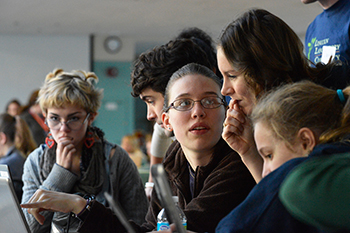In this section, Kristen Railey shares how she and the volunteers framed engineering as problem solving during the workshop. She also describes her reactions, as the instructor, when some of the girls encountered disappointment when their code did not work as planned.
Before the workshop started, we had to decide whether we would have the girls compile their own code on the Arduino boards, or if we would compile it for them ahead of time. We knew that if the girls compiled their own code, it might not work. We’d have to use a lot of the workshop time for debugging. If we compiled the code ourselves, it would work, but then we would be glossing over one of the key challenges of coding: problem solving. Ultimately, we decided to let the girls compile their own code and make mistakes, because we didn’t want the girls to get the impression that in engineering you get a set of instructions, follow them, and your code always works.

Kristen Railey problem solving with workshop participants. Courtesy of Jon Barron, MIT Lincoln Laboratory.
One of the early speakers in our workshop, an engineer who builds prosthetic feet for people in the developing world, also communicated the idea that engineering is about problem solving. She introduced the design process to the girls. She talked about how, as an engineer, you come up with an initial prototype, test it, get customer feedback, and then repeat the whole process to improve the design.
Throughout the workshop, we tried to emphasize that there are multiple solutions to problems, and that engineers try to solve problems by breaking them up into smaller parts. For instance, sometimes the girls became frustrated when their code didn’t work as planned. That’s when we talked to them about how to break down a problem. We modeled saying things like, “Okay, I’m going to get the first five lines of code to work. How do I test that?” We didn’t have as much time I as I would have liked to do that kind of thing, but I think it’s good to introduce girls to how to approach a problem, how to not give up, and how to think on your feet.
When we facilitated the session on building and testing a wearable circuit, most of the girls were able to get their shoes to illuminate, but not all were successful. The hard part, for me, was when we had an open discussion about this after the session. I asked them how they felt about not getting their shoes to light up. Some of them were pretty angry. Seeing their disappointment was difficult. But it’s funny, because I think every engineer has experienced this disappointment. For me, it was during sophomore year at MIT when I did not have a working robot for one of my classes. In future iterations of the workshop, I think it would be helpful for me, and the volunteers, to share with the girls our stories of failure and what we learned from these experiences.
